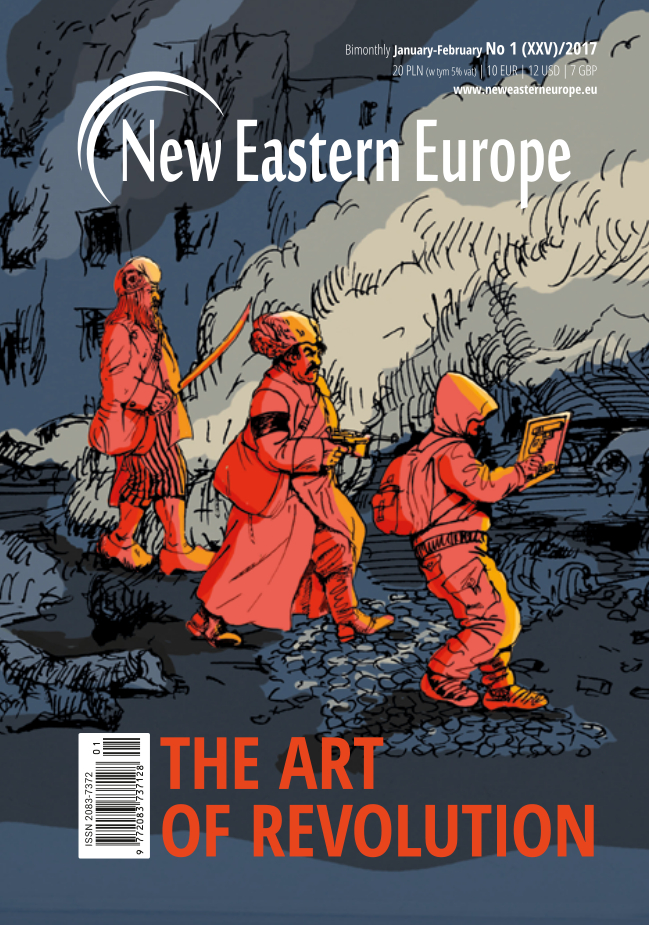Issue 1 2017: The Art of Revolution
August 30, 2016 -
New Eastern Europe
-
Issue

Get this issue delivered straight to your doorstep. Click here to subscribe online today.
In this issue we explore the phenomenon of Revolutions which has played a key role in this region for centuries: revolutions. We specifically look at the question as to whether revolution in Ukraine has become a permanent feature of that country’s political culture since independence 25 years ago. In this issue we return to the thesis that Paweł Kowal and Maciej Wapiński put forward three years ago in New Eastern Europe which adds the 1990 students’ hunger strike to the sequence of revolutionary events in Ukraine. Consequently, our authors map the country’s post-Soviet transformation through the prism of revolutionary events.
Naturally, political transformations, peaceful or not, have not been limited to Ukraine. They have been occurring in many areas of the post-Soviet space. This fact has been cherished in the West. However, the picture of Armenia, as penned down by Małgorzata Nocuń illustrates how such an assumption is not entirely correct. Even once a part of the same unit, we need to look at the post-Soviet republics as states that have taken different paths in the last decades and continue to experience different pressures from Russia. To understand this further we should cautiously follow the developments within them, as well as within Russia. A good start are three texts: Sean Guillory on the failure of the Russian protests to achieve any sustainable success, Daniel Wańczyk on the changes taking place in the life of the Arctic seen in the example of Vorkuta and Wojciech Siegień who notes the indoctrination through education that is now increasingly present in the Russian Federation.
We also take a look at the importance of Polish-Ukrainian relations in the future success of the region. These are mentioned in the pieces by Georges Mink, Kostiantyn Fedorenko and George Soroka. All the authors postulate on how painful historical memories still exist between the two nations and argue the need for their resolution. A review of the recent film Wołyń by Kaja Puto is an additional point in this debate.
Download the issue on your PC or mobile device
Preview the issue via Issuu:
WHAT’S INSIDE
OPINION AND ANALYSIS
Three Revolutions. A research project
Georges Mink, Paweł Kowal
Once a protester, always a protester
Kateryna Pryshchepa
We were acting as neighbours, as friends of Ukraine
Interview with Valdas Adamkus
New tools of the revolution
Roman Romanyuk
Beyond Maidan Nezalezhnosti
Nataliya Zubar, Vitalii Ovcharenko
High stakes in Ukraine. From revolution to reform
Kostiantyn Fedorenko
Three myths of Ukraine’s revolutions
Nataliia Pohorila
What makes a revolution (or not)
Diāna Potjomkina and Ilvija Bruģe
Whatever happened to “Russia without Putin”?
Sean Guillory
Talkin’ bout a revolution
Małgorzata Nocuń
Kyrgyzstan: a revolutionary drama
Christopher Schwartz
Putin pushing the envelope
Anton Barbashin
Consequences of Putin’s disinformation war in Europe
David Matsaberidze
Making the unreal real
Wojciech Siegeń
Combative pasts. The politics of history in post-communist Europe
George Soroka
Laying the groundwork for reconciliation
Georges Mink
INTERVIEWS
The shadow over Hungary’s history
An interview with Paul Lendvai
Shevardnadze could listen, but he did not hear
An interview with Nino Burjanadze
REPORTS
The black island of the Arctic
Daniel Wańczyk
Familiar strangers
Maxim Edwards
HISTORY AND MEMORY
Rock of ages
Jonathan Bousfield
His Highness’s life. Parallel to reality
Andrzej Zaręba
PEOPLE, IDEAS, INSPIRATION
Is it time to rebrand Eastern Europe?
A debate with Rebecca Harms, Balázs Jarábik, Cornelius Ochmann and Anastasia Sergeeva.
EASTERN CAFÉ
A film which divides Poles and Ukrainians
Kaja Puto
The spectre of neoliberalism
János Széky
A church for the state or churches for the people?
Przemysław Pazik
An unexpected focus on the South
Andriy Lyubka
Become a PRINT subscriber and enjoy access to ALL of our previous issues


































